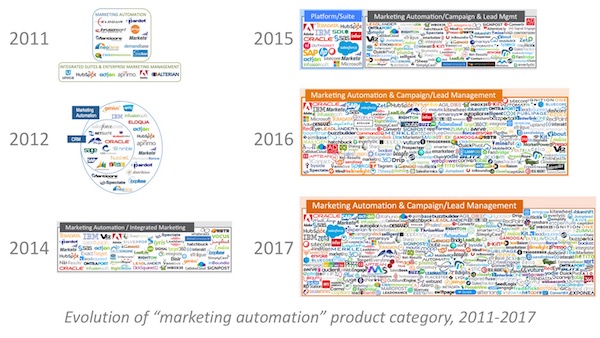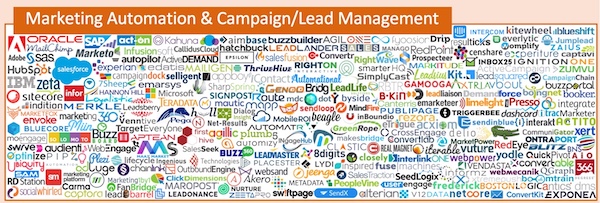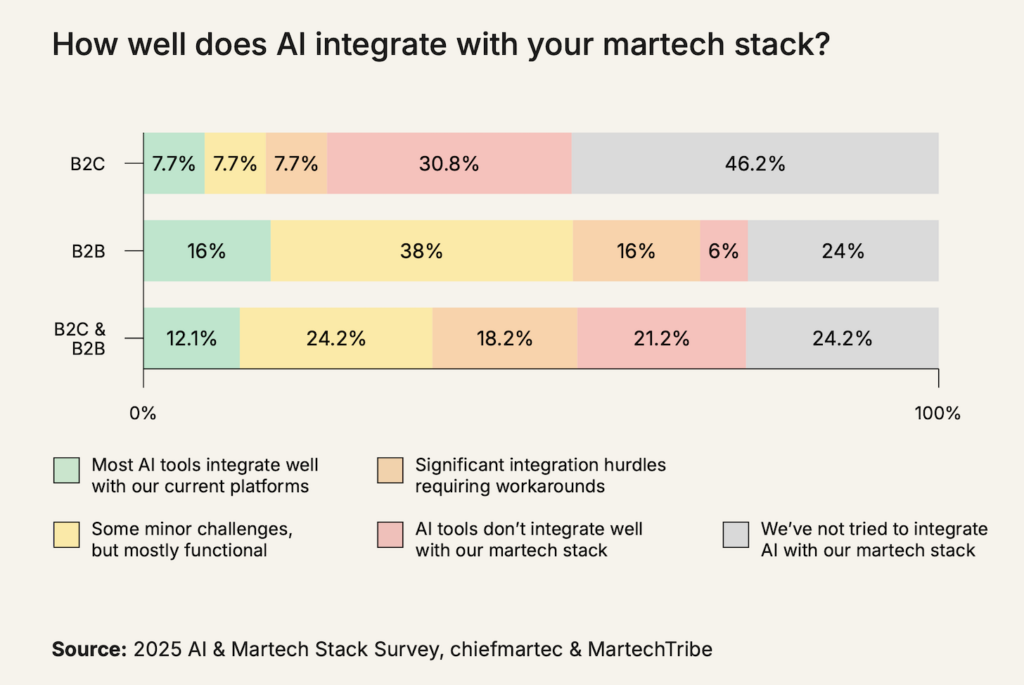tl;dr — From 2016 to 2017, the marketing automation category of the marketing technology landscape grew yet again, by 36%, from 156 vendors to 212. If you predicted it was going to consolidate in the past six years, sorry, you were wrong.
Marketing automation remains a bellwether of martech
It’s become a bit of a tradition here at chiefmartec.com: as I’m working on my yearly marketing technology landscape graphic, I release the “marketing automation” category in advance as a kind of sneak peek of what’s ahead.
Why marketing automation, which I crudely lump together with campaign management and lead management products? To me, it’s quintessential marketing software. It’s also a category that I’ve studied closely over the years, so I’m personally interested in its evolution. But most of all, I’ve found that it’s usually a bellwether for the rest of the landscape — the dynamics in this category tend to echo in many of the others.
But before sharing the 2017 version, here are three important notes:
- The complete 2017 marketing technology landscape will be released in two weeks on May 10, at the opening keynote of the MarTech conference in San Francisco. You won’t want to miss this event — read this preview to learn everything going on those two days.
- I’m incredibly grateful to have had a great collaborator on the landscape this year, Anand Thaker of IntelliPhi. Anand will join me for the MarTech keynote to share his perspective from working on this project these past few months and his eclectic engagement in this space over the last 15 years.
- Sorry, but we cannot add any other companies to this category at this stage of our production. If you think your firm should be included, please wait for the complete landscape — it’s quite likely that you’ll be represented elsewhere in the landscape. Thousands of other companies are.
So here’s the category — click for a larger version — followed by some commentary:
There are 212 vendors included in this category, up 36% from 156 in last year’s landscape. Specifically:
- 142 vendors remained unchanged from last year
- 4 vendors changed their name, focus, or ownership
- 10 vendors were removed — acquired and absorbed or went out of business
- 66 vendors were added
Yes, more than 5X as many vendors were added to this category than removed. Pause for a moment to let that observation sink in. (However, not all that were added are brand new ventures — some I had simply missed in my research last year.)
Anti-consolidation and the triumph of empiricism
Just to state the obvious: this is a lot of marketing automation (and related) vendors. Even I am surprised that this category — one that has been around, relatively speaking, for quite some time now — grew this much. But it drives home to me just how vibrant this market is, as the state-of-the-art in marketing and software rapidly advances and as marketers get more savvy and sophisticated in what they want the technology to do.
Yet I’m sure this will provoke the same attack response that it did last year, and the year before that, and the year before that, and so on: “Marketing technology is going to consolidate!”
Every year, the prophets of consolidation get more vociferous in their proclamations, even as the space continues to experience double-digit expansion.
Now, in all fairness, I’ve never said that the space won’t consolidate. It’s ultimately a question of when and to what degree — although those are pretty big questions, with a very wide range of possible answers. Consolidation can end up taking many forms. For instance, if you define consolidation by distribution of revenue, it is already happening.
But I would humbly invite those who have consistently dismissed the majority of these vendors as one-person ventures (many are small, but not that small), copycats (many are quite innovative), or generally unviable businesses (many eschew the classic VC funding model and become profitable quickly) to consider a little more humility in predicting the future.
Empirically, the category has not consolidated its number of vendors — quite the opposite — and most of these businesses have successfully sustained themselves for multiple years in the absence of VC funding. And if you read through all 212 of their websites, as I have, it’s hard not to be impressed by how many are offering really great products and services.
So if your mental model had you convinced that it would have consolidated by now, with the majority of these vendors in a deadpool, you might want to acknowledge that the dynamics of this market are perhaps — just perhaps — different than what you expected.
On the bright side, that opens up a far more interesting set of possibilities for you to contemplate: how the dynamics of cloud computing, open source, APIs and microservices, global collaboration, marketing’s scope creep, wave upon wave of new disruptive technologies, and every company in a digital world asymptotically becoming a software company to some degree could be shaping a whole new kind of software market.
Sure, maybe massive consolidation will happen anyway — maybe as soon as next year — and this will all regress to a 1990’s-style business software market. I concede that’s one possible outcome.
But if that’s the only future you can imagine, then it might not be the start-ups in this space who are the ones suffering from copycat thinking and a lack of innovation.
P.S. This marketing automation category, as wild as it is, is only a tiny piece of the overall marketing technology landscape. Come join us at the MarTech conference in two weeks to see first-hand how the rest of the market is evolving — and learn how leading brands are harnessing it to their advantage.
P.P.S. Here’s a quick reference to the previous martech landscapes:
- 2016 Marketing Technology Landscape
- 2015 Marketing Technology Landscape
- 2014 Marketing Technology Landscape
- 2012 Marketing Technology Landscape
- 2011 Marketing Technology Landscape
2 ways to attend MarTech
The ultimate MarTech experience: All Access Pass
Get the full MarTech experience for just $1,795, a $100 savings off on-site rates. You’ll get 3 days of networking with martech leaders and experts, more than 70 presentations and keynotes across 8 tracks, and demos and solutions from over 100 leading martech vendors. Also, you get breakfast, hot lunches, snacks all day and all of the structured and unstructured networking activities and conveniences that make attending MarTech a unique, productive and enjoyable experience. Register now.
Dive into the martech ecosystem with an Expo+ Pass
Meet more than 100 amazing martech vendors in the Expo Hall. You’ll find solutions and providers, attend full-length vendor presentations and connect with your peers at the 2 networking receptions including the Stackies awards ceremony. Buy an Expo+ pass now for just $99.





Just a bit of clarity Scott: of the 66 additions, how many were launched within the last year vs. not included from last year’s pièce de résistance?
Great question! We’re sorting through that data and should be able to release it with the full landscape on May 10.
Scott, as thought leaders, we need to find a way to simplify this image. CMOs and CEOs will literally “check out” when they see this. I hear loud groans when keynote speakers show the Luma Landscape. When marketing leader use this graph in a persuasive peer conversation, they lose trust. Here’s my take: http://www.huffingtonpost.com/entry/working-the-room-three-trust-traps-leaders-must-avoid_us_58fdf865e4b0f420ad99c9df
Great article, Lisa — thanks for sharing.
My humble opinion is that it’s important to see the empirical reality of the scope of the marketing technology landscape, even if it’s not comfortable to face. However, that’s a very narrow piece of the puzzle. I completely agree that what matters in making a presentation around marketing technology strategy and operations is to visualize your actual or proposed strategy and operations. And I’ll be the first to acknowledge that my graphic offers zero value on either of those fronts.
Would love to see any suggestions you have for how marketers could/should better visualize their approach to marketing technology strategy and operations — I’m sure there’s tremendous opportunity for innovation there.
Scott, I think the next technology milestone for your MarTech landscape is to get it off slide/paper and into an app where sorting criteria can easily filter the “ocean” of logos to focus on companies of interest based on the user’s input. Every logo would be clickable right into their company home page. And, since we can imagine anything, a user should be able to slap a Virtual Reality (VR) visor on their smartphone, view your app and visualize the landscape in 3D where the company logos of interest (based on the sort) float to the resolved foreground and the filtered out company logos float to the fuzzy background. That’s where this is going (maybe sooner rather than later). WPP recently invested $50M in the Austin-based tech company SubVRsive to create VR-based advertising “experiences” and, with all the money you are making on your conferences, you could probably entice them to work up a mock-up to test the viability of what I am suggesting. 🙂
Agreed — I think we’ll be able to do something really cool with this data. Stay tuned!
Scott, in my mind, we can help the entire martech industry cross the acclaimed Chasm. First, we might consider providing a search tool/app that a CIO or CMO executive can use. This might allow them to sort by business problem, industry, or goal. Right now, the focus is on tools and features, such as “events management” or “lead scoring.”
If you know of any apps developer or web design firm who would be interested in helping, I’d be happy to co-brand!
If this kind of product already exists, I’d love to refer our community to it.
— Lisa
Scott, Nice to see 2017 landscape is coming up well.
Marketing Automation space is indeed expanding, last year we were part of NASSCOM’s MarTech event in India & noticed many new entrants here.
This led us to research on Marketing Automation Industry in India, we started our research on the B2C space and found products offering industry specific solutions.We will be releasing B2C, Marketing Automation Report, India: 2017 (http://bit.ly/2mSPGem) by end of May17.
Landscape created by your team, has been an important reference point for the MarTech industry. Look forward to see the 2017 version.
Hi Scott-lovely article. I am seeing trends develop in the India & Asia market that somewhat mimic whats happening in the US. But I also see differences in terms of usage & how tech is being adopted by CMO’s. And yet my experience of investing in Marketing technology (earlier as a CMO & now as a service provider) tells me that buying technology is easy but to make it work, you have to make fairly large changes in Marketing strategy, team structure & available skills sets. I write about this here: https://elink.io/p/customer-iq-9130a
Wow! That’s a lot to choose from… I’ve recently started using GetResponse. I like it that apart from marketing automation there’s also a few other tools. It helps a lot.
We that are not based in the US missed this. Will there be any form of replay anywhere online so we could connect and learn too?